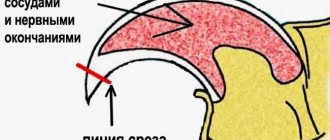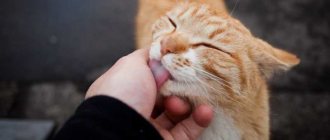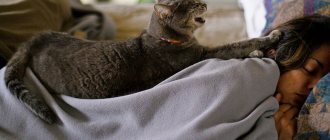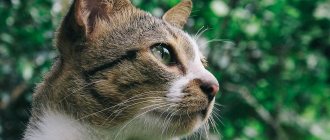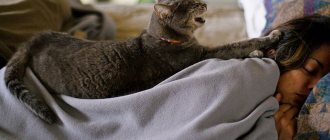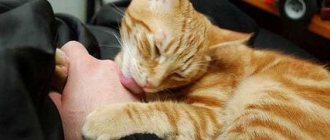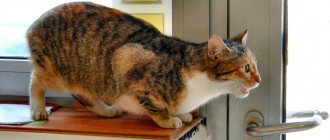Many mustachioed pets react positively to stroking, responding to affection with a loud purr and contented squinting. Soft fur and pleasant vibrations are the best anti-stress for a tired owner, but it is not always possible to relieve tension after work with their help. Even the most good-natured pets are sometimes not in the mood and greet their owner’s hand with a treacherous “bite.” Finding out the possible causes of dissatisfaction is quite simple if you know why cats love to be petted and which places on the body are best left untouched.
Choose the right time
It is very important to learn to understand your pet and choose the right time for affection. Cats value their personal space very much and hate it when it is violated, even with the best intentions.
You should not touch the animal when it is eating, going to bed, or grooming its fur. If the cat itself spins under your feet, touches the person with its paw, starts meowing, or just stares intently, then you can try to pet it.
You need to carefully reach out to your pet's nose. If he starts sniffing you, touching you with his nose, or even actively rubbing his muzzle, then this is a very good sign. This means that the animal can be stroked, but only along the fur.
If the cat completely ignores you, then this means that he is not in the mood to communicate with a person. If your pet backs away, turns away, or shows aggression, then you should not try to pet it.
The 22-year-old student graduated from college with her grandmother. Both with honors
Varnish, metal, perforation: trendy shoes for mid-spring 2021
As a means of reconciliation with her daughter, Maksakova asked her to learn to forgive
Where and when to pet a cat so that it likes it?
Having understood the main reasons for the love of stroking, we will find out exactly where cats like to be stroked. Besides the scent glands, there are a few other sweet spots.
Duration of the “caressing session”
The most important rule is to respect the interests and wishes of the pet. Be sure to leave the cat alone if he is not in the mood. Caress against one's will brings discomfort even if the points most sensitive to stroking are involved.
The permissible duration of a “petting session” varies from person to person, so be guided by your pet’s mood. If the purring has stopped, the body has tensed, the fur has stood on end, and the cat does not take his gaze off you or even hisses - let him be alone with himself.
Places allowed for stroking
In addition to almost the entire head and base of the tail, whiskered pets like to be touched on the neck, chest and back. It is difficult to reach these areas with your paws, so a light massage relieves existing itching and helps relax tired muscles.
The most controversial areas are the tummy, paws and tail, but there are exceptions here too. Some cats don't mind at all when these parts of their body are stroked.
Don't be afraid to experiment, but be sure to consider your pet's reactions. If he shows you his belly without fear, lets you touch his tail and is in no hurry to pull his paw out of your hand, rejoice. Your connection is as close as possible.
Pay special attention to the ears
Pets enjoy stroking between the ears. In addition, the cat gets a lot of pleasure from touching the area located between the base of the ear and the eyes.
You can run your fingers over the eyes themselves, from the lower corner of the eyes to the ears, of course only if the cat closes its eyes. You need to try to move softly and smoothly, without unnecessary pressure.
What about scratching?
Scratching involves a more intense impact, but cats also like it and resemble a massage. The greatest pleasure comes from touching the areas with odorous glands:
- chin;
- cheeks;
- between the ears;
- bald area between the eye and ear;
- base of the tail.
Animals use the pheromones they contain to mark their territory and owners. Voluntary “smearing” a person into a secret is a kind of declaration of love and an expression of respect for one’s mustachioed pets.
Beware of prohibited areas
Cats simply cannot tolerate touching their bellies. This is the softest place and attracts a person, but stroking this area will only end in irritation. The stomach is one of the most vulnerable places of a cat, which he will not always trust to a person.
Many pets don't like having their paws touched, as they probably just feel ticklish. If the animal withdraws its paws, then you should stop stroking.
Another restricted area is the tail. It has many nerve endings and touching this area can cause discomfort.
Found a violation? Report content
Do all cats love to be petted?
Love for affection depends on 2 important factors: the character of the animal and the level of trust in the person. Because of this, aggression and discontent are most often shown by:
- shy and reserved pets who cannot tolerate close contact;
- street cats, accustomed to living in constant danger.
In the first case, the animal can still love its owner, but due to its temperament, it will be uncomfortable with overly intrusive attention. In the second case, the cat's behavior can be changed if you earn his trust.
Separately, it is worth noting the avoidance of stroking, which is uncharacteristic for a pet. If your pet loves affection, but has been stubbornly avoiding it lately and even hisses when touched, make an appointment with the veterinarian. He is most likely in pain and needs treatment.
Also, the behavior of the animal may differ from the one who strokes it. Most cats do not like to be petted by strangers, but are happy to sit on the laps of their owners.
Exceptions
Even large animals, such as a horse or a cow, for example, love affection and stroking. A tender attitude towards them also forms a stable connection, and touches form devotion. But this aspect does not concern birds . Yes, many domestic parrots, for example, are calm about people’s touches and even enjoy them, but there is no association with the image of the mother.
Birds are an exception
It's simple: birds do not lick their chicks, they clean the young with their beaks . And their memory is weaker, which excludes the formation of associations with periods of life that are already in the past.
Interesting: Why is Christmas on January 7th? Reasons, photos and videos
Only mammals can truly enjoy human touch , and those of them that were either born domesticated and had contact with humans since childhood, or were timely and competently tamed with the formation of complete trust in humans.
Thus, pets love to be petted as they associate it with their mother's touch. Cats, dogs and other animals lick their young to maintain cleanliness, and human stroking most closely resembles the touch of a mother's tongue. If you pet your cat or dog, it knows that you love and care for it, this gesture is understandable to animals without any translation.
Cats hugging each other
Cats look like they are hugging when they curl up together. Yes, cats can find themselves in very strange positions to get as close to each other as possible. But in reality, cats huddle together to stay warm and stay warm, even if it's hot in your home.
So, what may look like a cat hug is a random position they've fallen into to keep warm.
It's clear that we humans are very social, we can enjoy physical contact (especially hugging furry, cute animals).
We love our cats and want them to love us and show it in ways we are used to seeing, but we may unintentionally attribute human behavior to them. Of course cats are clearly capable of showing a lot of physical affection, it's just that our interpretation of a hug may be different from theirs, and that's something to keep in mind!
Cats hugging toys
Other images that, for example, show cats hugging a toy can also be misinterpreted.
Typically what they do is grab a toy with their front paws and scoop it up with their back legs in a "bunny" style, something that cats instinctively do either when playing or when they are involved in a fight with another cat.
They do this to cause as much damage as possible to their opponent, which you will know if the cat mistakes your hand for their opponent!
Why does a cat bite? Read here!!!
About sensitive areas of the cat's body
An animal has many such areas:
- The area between the ear and eye. As a rule, it is not densely covered with hair in kittens and adults. Most of the scent glands are located there, precisely those with which the cat marks its territory.
- Middle of the forehead, area between the ears.
- The area of the muzzle between the nose and lips. These are the areas where the mustache grows. With such areas, cats and kittens always rub against the owner’s legs, marking him, as well as objects in the house, furniture.
- Lips, chin. When the owner gently scratches the lower part of the chin, the cat simply becomes touched and lifts his neck up, purring contentedly.
- The lower back is the base of the tail. It is difficult for a cat to scratch such a place on his own. He will be grateful to the owner for the massage.
- Stomach. Although animals do not have specific glands in this part of the body, the sensitivity of the zone is high. A cat can trust stroking its belly only to its closest person - its owner. A pregnant cat becomes calmer and more sensitive to touch. However, in recent weeks you should not stroke her belly - it is unpleasant for her.
The most sensitive areas of cats
The favorite places for stroking are those areas of the cat's body where the aforementioned “odorous” glands are located, or rather those where there are the largest number of them. For this reason, the most “pleasant” places are:
- The middle of the forehead located between the ears.
- The area located between the ear and eye. This area in cats is somewhat “bald” due to the sparser fur than on the rest of the body. Moreover, it is rarer not only in adults, but also in small kittens. It is assumed that this is where the maximum number of “scent” glands are located, with which the cat marks its property.
- Angle between nose and lips. These are the very places where cat whiskers grow. This is the area where a cat most often rubs against household furniture and its owner’s legs.
- Lips and chin: scratching these places gives cats the most pleasure.
- The lower part of the back located at the base of the tail.
There are no scent glands on the abdomen, but this area is very sensitive to touch. And only if the pet has maximum trust in its owner will it lie on its back and allow it to stroke its belly.
Who is the head in this house
All people understand that they are stronger, smarter and bigger, but often the reason for restraint on the part of a cat is the awareness of the same thing. And if the owner demonstrates that he is in charge at every opportunity, then you should not be surprised that the cat will feel uncomfortable.
Let the cat at least sometimes feel like a mistress.
Do not forget that cats living in natural conditions are loners, and if they feel that they are being subjugated, they simply leave their territory to where they will be the absolute masters. A domestic cat cannot do this, so it only experiences aggression and stress. There is no need to confuse dogs and cats. Under no circumstances should dogs be placed on the same level as you, but a cat will be more affectionate the more self-confident she feels.
To make a cat become affectionate, you should try hard.
Therefore, it is better to be careful with manifestations of your superiority and various punishments: an increasingly frightened cat is almost unable to perceive information. However, you shouldn’t spoil your pet either. You should not confuse an affectionate cat with an insolent one. It is quite enough to simply control yourself and not stoop to shouting, coercion and punishment.
By being patient and having free time, you can make even the most inert cat affectionate and trusting.
The main weapon should be cunning and persuasion. If a cat has done something wrong, you can pretend to be a big cat and hiss, but if she has done something right, she must be praised.
Cat hugs dog
Throughout history, cats and dogs have been portrayed as not the best of buddies, we even coined the phrase "like cats and dogs"!
Yes, cats and dogs are two species on opposite ends of the social and behavioral spectrum - cats like to evaluate new situations from a distance, while dogs try to immediately take part in any event.
Let's say a dog approaches a cat, the cat will perceive it as a threat and will likely run away, eliciting a playful response from the dog. It is clear that neither the cat nor the dog understands the intentions of the other.
So, for a cat to be close enough to a dog to hug him, she shouldn't be afraid of him. A typical case is when a cat grew up with a dog as a kitten and puppy and does not perceive him as a threat.
She will even use the dog as a comfortable, warm bed, but this is the exception rather than the rule, and making friends between a cat and a dog is not so easy.
Why do cats like being stroked?
First of all, we note that cats have the most sensitive areas on their bodies. Vibrises are located there. These are hairs, similar in structure to whiskers, but smaller and thinner, they serve as the cat’s organs of touch. If you stroke your pet in the direction of the growth of the whiskers, she becomes very pleased, she is very pleased with such attention. But when you move your hand against the fur, the cat experiences discomfort. And if we are talking about representatives of short-haired breeds with coarse hair, then they even experience pain if stroked incorrectly. In this case, pets may simply stand up abruptly and run away, offended.
Memories of childhood
A cat licks a kitten As cubs, all animals are in close contact with their parents, at least with their mother.
The mother not only feeds them, but also ensures cleanliness. Maintaining hygiene and even stimulating digestion in young mammals is achieved by licking. The mother carefully grooms the babies with her tongue and does this several times a day. The feeling of licking is remembered by the cubs for a long time, often for life . It is associated with the presence of the mother, and therefore with safety and satiety.
Exchange of smells
Why does a cat, when it meets its owner, rub its muzzle against his clothes? Some believe that she is being caressed in this way. However, this is not quite true. Cats have glands on their faces that secrete a special substance. When a pet rubs against its owner, it leaves its scent on the clothes - it marks it. You may not be able to detect the scent, but other animals can distinguish it very clearly.
The most acceptable way to exchange scent is through stroking. After all, the glands are located not only on the muzzle, but also in the area of the ears, on the pads of the paws and lower jaw. If the cat begins to move its paws, it stimulates the secretion of secretions from the glands.
Height
For an animal to be sociable and trusting, it must feel completely safe. What will a cat do if it suddenly feels threatened? Most likely, he will run away and climb a tree. Under natural conditions, a cat that has climbed to a height has almost no one to fear. Therefore, you should make sure that your cat has plenty of high places to hide.
Cats do not know how to obey; they are loners by nature.


